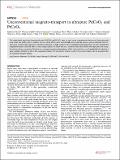Files in this item
Unconventional magneto-transport in ultrapure PdCoO2 and PtCoO2
Item metadata
| dc.contributor.author | Nandi, Nabhanila | |
| dc.contributor.author | Scaffidi, Thomas | |
| dc.contributor.author | Kushwaha, Pallavi | |
| dc.contributor.author | Khim, Seunghyun | |
| dc.contributor.author | Barber, Mark E. | |
| dc.contributor.author | Sunko, Veronika | |
| dc.contributor.author | Mazzola, Federico | |
| dc.contributor.author | King, Philip D.C. | |
| dc.contributor.author | Rosner, Helge | |
| dc.contributor.author | Moll, Philip J.W. | |
| dc.contributor.author | König, Markus | |
| dc.contributor.author | Moore, Joel E. | |
| dc.contributor.author | Hartnoll, Sean | |
| dc.contributor.author | Mackenzie, Andrew P. | |
| dc.date.accessioned | 2019-01-10T16:30:07Z | |
| dc.date.available | 2019-01-10T16:30:07Z | |
| dc.date.issued | 2018-12-18 | |
| dc.identifier | 257304904 | |
| dc.identifier | 40ad6e43-d5a0-44c1-b176-9e46dfea98d8 | |
| dc.identifier | 85058848342 | |
| dc.identifier | 000463713200001 | |
| dc.identifier.citation | Nandi , N , Scaffidi , T , Kushwaha , P , Khim , S , Barber , M E , Sunko , V , Mazzola , F , King , P D C , Rosner , H , Moll , P J W , König , M , Moore , J E , Hartnoll , S & Mackenzie , A P 2018 , ' Unconventional magneto-transport in ultrapure PdCoO 2 and PtCoO 2 ' , npj Quantum Materials , vol. 3 , 66 . https://doi.org/10.1038/s41535-018-0138-8 | en |
| dc.identifier.issn | 2397-4648 | |
| dc.identifier.uri | https://hdl.handle.net/10023/16839 | |
| dc.description | We acknowledge the support of the Max Planck Society, support from the European Research Council (through the QUESTDO project), and the Engineering and Physical Sciences Research Council, UK (grant no. EP/I031014/1). T.S. acknowledges support from the Emergent Phenomena in Quantum Systems initiative of the Gordon and Betty Moore Foundation, V.S. thanks EPSRC for PhD studentship support through grant number EP/L015110/1 and J.E.M acknowledges the support of NSF DMR-1507141. | en |
| dc.description.abstract | The single-band, quasi-two dimensional metals PdCoO2 and PtCoO2 have recently come to prominence because of their extremely long mean free paths, which establish them as some of the most electronically pure materials known, and as potential hosts of previously unobservable regimes of electronic transport. To fully establish their magnetotransport properties, we have studied the magnetoresistance and Hall effect in bulk single crystals to which electrical contacts have been made with high precision using focused ion beam machining. We observe a strong temperature dependence of the Hall resistivity in small applied fields, linked to a large violation of Kohler’s rule in the magnetoresistance. We discuss the extent to which these observations can be accounted for by standard transport theory. | |
| dc.format.extent | 16 | |
| dc.format.extent | 1531887 | |
| dc.language.iso | eng | |
| dc.relation.ispartof | npj Quantum Materials | en |
| dc.subject | QC Physics | en |
| dc.subject | Condensed Matter Physics | en |
| dc.subject | Electronic, Optical and Magnetic Materials | en |
| dc.subject | NDAS | en |
| dc.subject.lcc | QC | en |
| dc.title | Unconventional magneto-transport in ultrapure PdCoO2 and PtCoO2 | en |
| dc.type | Journal article | en |
| dc.contributor.sponsor | EPSRC | en |
| dc.contributor.sponsor | EPSRC | en |
| dc.contributor.institution | University of St Andrews. School of Physics and Astronomy | en |
| dc.contributor.institution | University of St Andrews. Condensed Matter Physics | en |
| dc.identifier.doi | 10.1038/s41535-018-0138-8 | |
| dc.description.status | Peer reviewed | en |
| dc.identifier.grantnumber | EP/I031014/1 | en |
| dc.identifier.grantnumber | EP/L015110/1 | en |
This item appears in the following Collection(s)
Items in the St Andrews Research Repository are protected by copyright, with all rights reserved, unless otherwise indicated.

